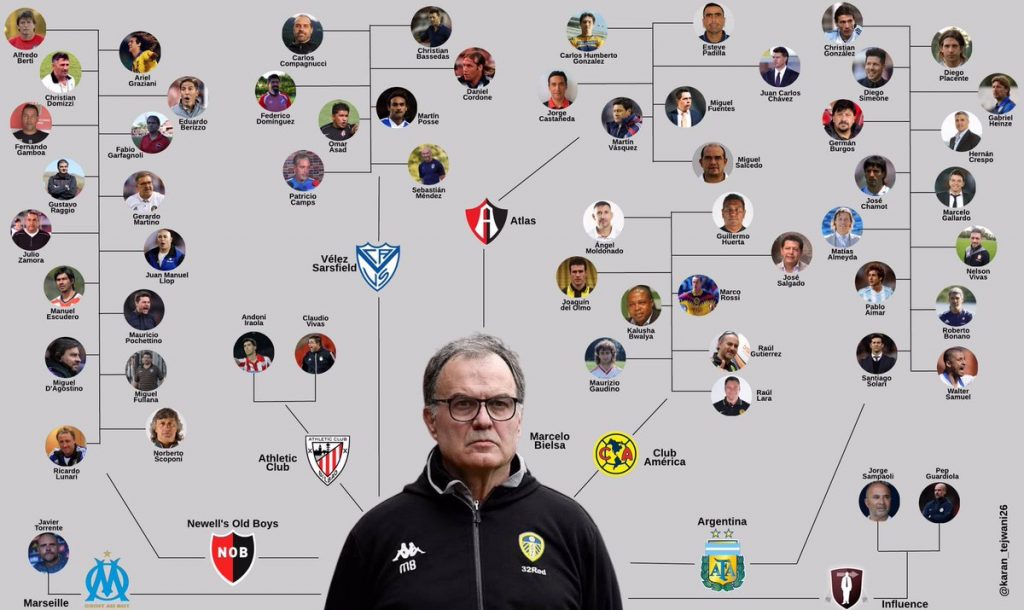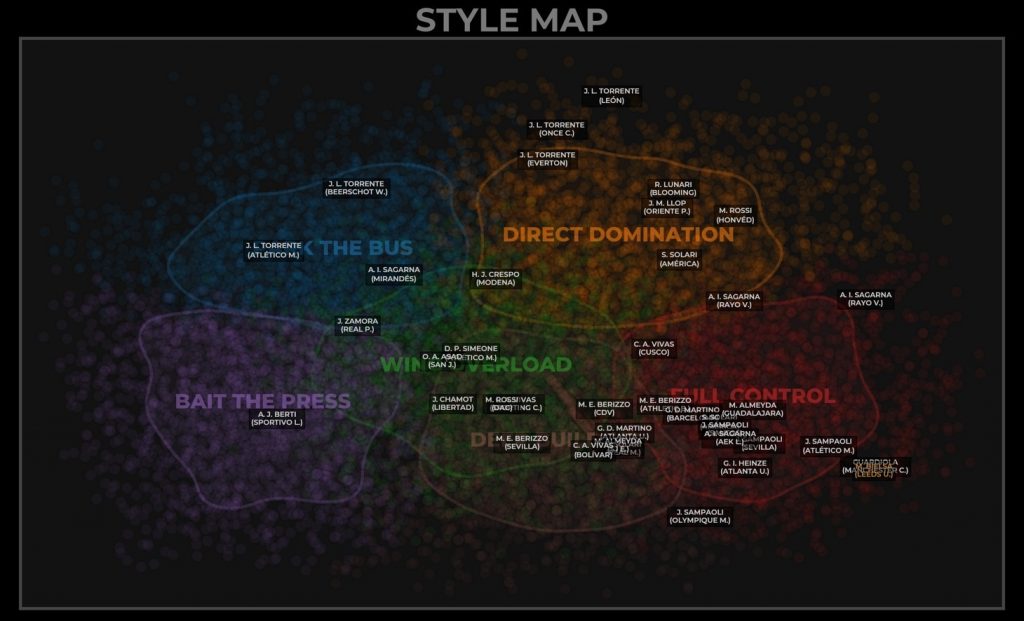Marcelo Bielsa’s influence on football is widespread, but not every coach he’s worked with follows his plan. Alex Stewart looks at the case of Javier Torrente
Pep Guardiola once described Marcelo Bielsa as “the man who knows more about football than anyone else”. Guardiola, arguably the greatest coach of the modern era, has been profoundly influenced by Bielsa, not least during their fabled 11-hour meeting in Mexico a year before the Spaniard became Barcelona’s B-team coach. Guardiola has also said of Bielsa: “We are judged by how much success we have, how many titles we have won. But that is much less influential than how he has influenced football and his football players. That is why, for me, [Bielsa] is the best coach in the world.”
Bielsa never coached Guardiola as player; their relationship is based on conversations rather than an immediate working relationship. But Bielsa’s influence is far more concrete on a host on current managers and coaches, with whom he worked when they were players. There are also many who worked under him as coaches or assistant managers, either when Bielsa was head coach/manager or Director of Football, as he was at Atlas.
This excellent map by Karan Tejwani shows a significant number of the coaches that have either worked under Bielsa as players, such as Mauricio Pochettino or Diego Simeone, as well as those he has influenced like Pep or Jorge Sampaoli, an avowed Bielsa disciple who has recently taken over at Sevilla after coaxing some scintillating football from Marseille.

Using Analytics FC’s Coach Style Map, we can plot how that stylistic influence has propagated through football in terms of how teams have played under Bielsa-influenced coaches. Generally speaking, the pattern is what one might expect: a number of coaches who have played under Bielsa and been shaped by his ideas play a similar style, or something relatively close. Here’s map, and Bielsa’s Leeds tenure is highlighted in gold at the bottom right:

In order to read the map, we can use Analytics FC’s visual taxonomy of coaching styles:
Park the bus: this style focuses on setting up to defend deep out of possession and using counter-attacks as the main means of generating chances.
Direct domination: a style of play characterised by high pressing out of possession and a similarly direct approach when in possession.
Bait the press: this style sees a low block defensively, while in possession some short passing occurs deep, but with the intention of encouraging the opponent to press and then attack with long balls either in behind or towards a target man
Wing overload: the emphasis in this style is on combination play in wide areas and a reliance on wing-play, crosses, and cutbacks to generate chances
Deep build-up: this style is built on lots of short passes and a high volume of passing in possession, while there is an emphasis on pressing high out of possession
Full control: another high pressing style, but one that combines high pass circulation numbers and the ability to pin opponents deep in their half
Few teams are distinctly one of these styles; most show elements of several, which is why a map is useful.
There are clear clusters around ‘full control’ and ‘deep build-up’, while another group sit towards the right-hand-side of ‘direct domination’, where there is classic Bielsa verticality and pressing but less of an emphasis on retention.
One thing that’s important to realise is that generally speaking, coaches tend to stay fairly consistent on the vertical axis, but will move along the horizontal axis depending on quality of playing staff. This means that a ‘deep build-up’ coach moving to a better squad will tend to become a ‘full control’ coach, as their players can retain possession higher up the pitch with greater ease. But a ‘park the bus’ coach, who will counter from a low block, tends not to become a ‘bait the press’ coach, however their playing squad changes.
Which brings us to Javier Torrente. While a few coaches on our map, Ricardo Lunari, Juan Manuel Llop, and Marco Rossi, have a presence in the top half of the map, no one is there as consistently as Torrente. Torrente exemplifies the theory that a coach stays roughly level on the vertical axis, in this instance using a direct, vertical style, but moves along the horizontal varying on club quality. This effectively means, in his case, the intensity of pressing and height of the defensive line: the better the club, the more Torrente tries to get his teams to press high and play with verticality from a higher line.
But most Bielsa coaches are on the bottom half of the map. Why has Torrente consistently eschewed a more possession-focussed game, like that of his mentor?
Javier Torrente actually started his professional coaching career as a fitness specialist. He worked with age level teams in the Newell’s Old Boys set-up and then got offered promotion to working with the first team squad at Atlas in Mexico when a vacancy arose and Bielsa, then Atlas’ Director of Football, hired him.
Torrente was therefore not a player under Bielsa, or a tactical or technical coach. His background in fitness may point to why he’s developed his own sense of how football can be played, more direct, more counter-attacking. That’s not say that Bielsa isn’t an influence on him. In this excellent piece on Coaches’ Voice, it’s clear that Torrente learned a lot from Bielsa while following him to a host of clubs and the Argentinian national team, both in terms of application and work ethic and also the creation of training drills.
Torrente’s first job as head coach was at Cerro Porteño in Paraguay.
He told Coaches’ Voice:
The first few days, people were expecting to see something similar to what Marcelo promotes. The ‘Bielsa stamp’, like is said about all of us who have worked with him. In football, though, you can’t coach using someone else’s little book. In the end, copies don’t work.
But, despite learning how to coach, Torrente seems not to have borrowed what to coach.
That doesn’t mean to say there aren’t things I do in a similar way to Marcelo, but in others I distance myself because my characteristics are different. It would be an enormous lack of respect on my part to want to compare myself with Marcelo. You just have to look at where he has got to and what he has achieved.
There may be a tacit acknowledgement here that Bielsa’s style is so difficult to coach that while his methodology, his drills and analysis for example, may be transferrable, it’s not necessarily a great idea to try to apply his style consistently.
Interestingly, Torrente then rejoined Bielsa at Marseille, after several years making his own way as a head coach. He then left to take over at Once Caldas, and that and his following roles are the jobs that we can see on our map.
Of course, all the above coaches have held roles at a huge array of clubs. While Matías Almeyda and Sampaoli, a follower of Bielsa but one who never played for him, are averaging over 1.50 points per game in their respective careers, Torrente is at 1.27 since leaving Bielsa at Marseille, while Bielsa himself is averaging 1.44 (not including national team roles). But these differences cannot be explained by style, or even application of style, given the huge variety of clubs under consideration, from River Plate and Marseille and Sevilla, to San Jose and Emelec and Beerschot.
But it is interesting to see how a coach so closely aligned with Bielsa professionally, and one who clearly holds him in huge esteem, is rather unusual in how much he diverges stylistically. Javier Torrente may have learned a lot from Bielsa, but he doesn’t feel the need or want to follow his approach.
With thanks to Phil Hay for his pointers on this piece
Header image: Shutterstock/Maxisport














